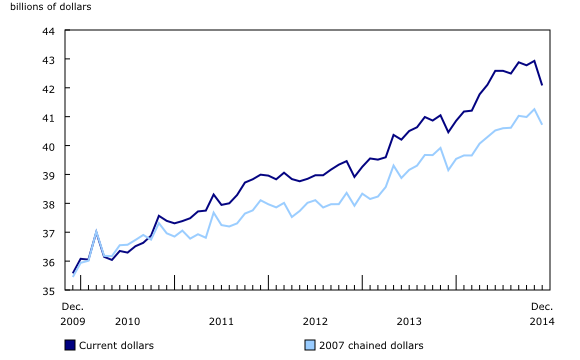Retail trade, December 2014
Archived Content
Information identified as archived is provided for reference, research or recordkeeping purposes. It is not subject to the Government of Canada Web Standards and has not been altered or updated since it was archived. Please "contact us" to request a format other than those available.
Released: 2015-02-20
Retail sales fell 2.0% to $42.1 billion in December. This was the largest decline since April 2010.
After removing the effects of price changes, particularly lower gas prices, sales in volume terms declined 1.3%.
Lower sales were reported in 9 of 11 subsectors, representing 71% of retail trade.
Retail sales decrease in December
Sales at gasoline stations fell 7.4% in December, reflecting lower prices at the pump. This was the sixth straight monthly decrease and the largest decline since December 2008.
Lower sales at new car dealers accounted for most of the decrease at motor vehicle and parts dealers (-1.0%). After peaking in September, sales at new car dealers (-1.0%) declined for the third month in a row. Weaker sales were also reported at automotive parts, accessories and tire stores (-4.8%) and other motor vehicle dealers (-0.7%). Sales at used car dealers rose 3.1%, the second consecutive monthly gain.
The largest increase in dollar terms came from a 1.0% gain at food and beverage stores, reflecting higher sales at beer, wine and liquor stores (+4.0%), specialty food stores (+3.1%) and convenience stores (+2.3%). Sales at supermarkets and other grocery stores edged down 0.1% in December.
Weaker holiday sales
Most store types typically associated with holiday shopping registered weaker sales in December, more than offsetting November gains in these subsectors.
Receipts at clothing and clothing accessories stores declined 5.6%. Lower sales at clothing stores (-6.0%) accounted for most of this decline. Following a double-digit gain in November, sales at shoe stores fell 9.4% in December. Jewellery, luggage and leather goods stores posted a 1.8% gain, the third increase in four months.
The 9.2% drop in sales at electronics and appliance stores more than offset the gains of the previous six months. The decrease was widespread across most product types.
General merchandise store receipts declined 2.0% in December, led by a 3.9% decrease at department stores.
Sales at sporting goods, hobby, book and music stores declined 1.3%, partially offsetting the sales gain in November. Lower sales at sporting goods stores offset gains made at hobby, toy and games stores.
Sales down in every province
Retail sales were down in every province in December.
Ontario (-2.3%) reported the largest decrease in dollar terms, with widespread declines across most store types.
Sales declines in the Prairie provinces were mainly a result of lower sales at gasoline stations and motor vehicle and parts dealers. Sales in Alberta (-2.5%) and Saskatchewan (-3.6%) were both down for the third consecutive month. Sales in Manitoba decreased 2.8% in December, more than offsetting the gain in November.
British Columbia reported a 2.2% decrease in December, with widespread declines.
Lower sales at gasoline stations accounted for most of the decline in Quebec (-0.5%). Results for other types of retailers were mixed.
Among the Atlantic provinces, New Brunswick (-1.9%) reported the largest decrease in dollar terms.
It is possible to consult tables of unadjusted data by industry and by province and territory in the Tables by subject module of our website.
For information on related indicators, refer to the Latest statistics page on our website.
Note to readers
All data in this release are seasonally adjusted and in current dollars, unless otherwise noted. For more information on seasonal adjustment, see Seasonally adjusted data – Frequently asked questions.
Total retail sales expressed in volume are calculated by deflating current dollar values using consumer price indexes. The retail sales series in chained (2007) dollars is a chained Fisher volume index with 2007 as the reference year. For more information, see Calculation of Volume of Retail Trade Sales.
The December 2014 issue of Retail Trade (Catalogue number63-005-X) will soon be available.
Data on retail trade for January will be released on March 20.
Contact information
For more information, or to order data, contact us (toll-free 1-800-263-1136; 514-283-8300; infostats@statcan.gc.ca).
For analytical information, or to enquire about the concepts, methods or data quality of this release, contact Jason Aston (613-951-0746; jason.aston@statcan.gc.ca), Retail and Service Industries Division.
- Date modified:


